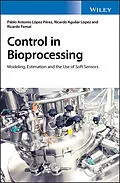Closes the gap between bioscience and mathematics-based process engineering
This book presents the most commonly employed approaches in the control of bioprocesses. It discusses the role that control theory plays in understanding the mechanisms of cellular and metabolic processes, and presents key results in various fields such as dynamic modeling, dynamic properties of bioprocess models, software sensors designed for the online estimation of parameters and state variables, and control and supervision of bioprocesses
Control in Bioengineering and Bioprocessing: Modeling, Estimation and the Use of Sensors is divided into three sections. Part I, Mathematical preliminaries and overview of the control and monitoring of bioprocess, provides a general overview of the control and monitoring of bioprocesses, and introduces the mathematical framework necessary for the analysis and characterization of bioprocess dynamics. Part II, Observability and control concepts, presents the observability concepts which form the basis of design online estimation algorithms (software sensor) for bioprocesses, and reviews controllability of these concepts, including automatic feedback control systems. Part III, Software sensors and observer-based control schemes for bioprocesses, features six application cases including dynamic behavior of 3-dimensional continuous bioreactors; observability analysis applied to 2D and 3D bioreactors with inhibitory and non-inhibitory models; and regulation of a continuously stirred bioreactor via modeling error compensation.
* Applicable across all areas of bioprocess engineering, including food and beverages, biofuels and renewable energy, pharmaceuticals and nutraceuticals, fermentation systems, product separation technologies, wastewater and solid-waste treatment technology, and bioremediation
* Provides a clear explanation of the mass-balance-based mathematical modelling of bioprocesses and the main tools for its dynamic analysis
* Offers industry-based applications on: myco-diesel for implementing "quality" of observability; developing a virtual sensor based on the Just-In-Time Model to monitor biological control systems; and virtual sensor design for state estimation in a photocatalytic bioreactor for hydrogen production
Control in Bioengineering and Bioprocessing is intended as a foundational text for graduate level students in bioengineering, as well as a reference text for researchers, engineers, and other practitioners interested in the field of estimation and control of bioprocesses.
Autorentext
Pablo Antonio López Pérez, PhD, is Professor at Escuela Superior de Apan, Universidad Autónoma del Estado de Hidalgo, México. His research focuses on Modeling, simulation and nonlinear control of Reactors, Bioreactors and Photobioreactors.
Ricardo Aguilar López, PhD is Professor at the Department of Biotechnology and Bioengineering, Center for Research and Advanced Studies (Cinvestav), México. His research interests include modeling of biosystems and bioprocesses, dynamic analysis in bioreactors and design of nonlinear control schemes applied to biological systems, as well as the development of online bioprocess monitoring schemes.
Ricardo Femat, PhD was the General Director of the Institute for Scientific and Technological Research of San Luis Potosi (IPICYT), and a Professor in the Department of Applied Mathematics in México. His research interests include (i) analysis, characterization and control of systems with complex dynamics, (ii) the regulation of glucose level in diabetics and (iii) the control of processes with reaction and diffusion.
Inhalt
Preface xi
Part I Overview of the Control and Monitoring of Bioprocesses and Mathematical Preliminaries 1
1 Introduction 3
1.1 Overview of the Control and Monitoring of Bioprocesses 3
1.1.1 Why Nonlinear Control in Bioprocesses? 3
1.2 Improvements to Bioprocesses Productivity 13
1.2.1 Cell Lines 16
1.2.1.1 Cell Culture Process General 18
1.2.2 Microorganism Growth Under Controlled Conditions 18
1.2.3 On the Environment for the Microorganism's Growth 19
1.2.4 Improving the Productivity for Specific Metabolic Products 21
1.3 Bioprocess Control 22
1.3.1 What is a Bioprocess? 22
1.3.2 Bioprocess Monitoring and Control 23
1.3.3 Stability of Bioprocess 25
1.3.4 Basic Concepts and Controllers 27
1.3.5 Advanced Control Schemes: Multivariable Control, Robust, Fuzzy Logic, Model Predictive Control, or Others 30
1.4 Process Measurements 32
1.4.1 The Drawback for Monitoring Bioprocess 32
1.4.2 Primary on-Line Sensor (e.g. Dissolved Oxygen, Temperature, Culture pH, Pressure, Agitation Rate, Flow Rates, Redox, CO2, and Others) 33
1.4.3 Primary in-Line Sensor 33
1.4.4 Process Analytical Technologies (Gas Analysis, Spectrometers, Infrared, HPLC, PCR, and Others) 34
1.4.5 Software Sensor (e.g. Cell Mass Estimation Via Complex Medium, Primary Carbon Substrate, Concentration Product of Line, Metabolites, Sensor to Computer Via Wireless) 36
1.5 Dynamic Bioprocess Models 40
1.5.1 Bioprocess Modeling for Control Purposes 40
1.5.2 Mass and Energy Balance of the Bioprocess 41
1.5.2.1 Dynamical Mass Balance 41
1.5.2.2 Batch Process 42
1.5.2.3 Fed-Batch 42
1.5.2.4 Continuous 43
1.5.2.5 Energy Balance 43
1.5.3 Black Box, White Box, and Gray Box Models 45
1.5.3.1 Black Box 45
1.5.3.2 White Box 45
1.5.3.3 Gray Box 45
1.5.4 Linear and Nonlinear Models 45
1.5.5 Segregated and Non-segregated Models 46
1.5.6 Structured and Unstructured Models 46
1.5.7 Structured Models 47
1.6 Process Optimization 51
1.6.1 Off-Line and On-Line Optimization of Bioprocesses 51
References 53
2 Mathematical Preliminaries 63
2.1 Systems of Ordinary Differential Equations 63
2.1.1 Differential Equations, Vector Fields, and State-Space Description 64
2.2 Linear Systems 70
2.2.1 The Fundamental Theorem for Linear Systems 70
2.2.2 Linear Systems in R2 71
2.2.3 Complex Eigenvalues 71
2.2.4 Multiple Eigenvalues 72
2.3 Nonlinear Dynamical Systems and its Analysis 72
2.3.1 Preliminary Concepts and Definitions 72
2.3.1.1 Continuous Dynamical Systems 73
2.3.1.2 Phase Space and Phase Portrait 73
2.3.1.3 Trajectories of Autonomous and Non-Autonomous Systems 73
2.3.1.4 The Vector Field 74
2.3.1.5 Lipschitz Condition 74
2.3.2 Existence-Uniqueness Theorem 75
2.3.2.1 Algebraic Properties of Lipschitz Continuous Functions 76
2.3.3 Dependence on Initial Conditions and Parameters 77
2.3.4 The Flow Defined by a Differential Equation 78
2.3.4.1 Differential Flow 78
2.3.5 Equilibrium Points 79
2.3.5.1 Equilibrium 79
2.3.6 The HartmanGrobman Theorem 80
2.3.7 The Stable Manifold Theorem 81
2.3.8 Saddles, Nodes, Foci, and Centers 82
2.3.9 Center Manifold Theory 84
2.4 Stability Theory via Lyapunov Approach 84
2.4.1 Stability Notions 84
2.4.1.1 Stability 84
2.4.1.2 Asymptotic Stability 85
2.4.1.3 Exponential Stability 86
2.4.2 The Direct Method of Lyapunov (Second Method) 86
2.4.2.1 Positive Function 86
2.4.2.2 Theorem of Lyapunov 87
2.4.2.3 Globally Uniformly Asymptotically Stable of Lyapunov 88
